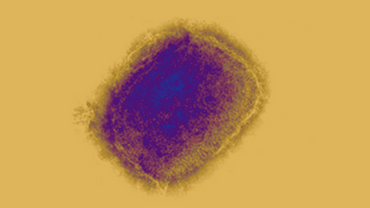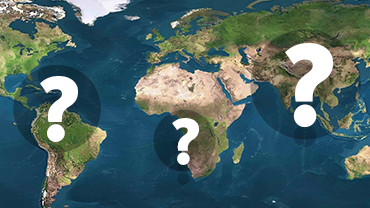Epidemiological update: Monkeypox multi-country outbreak
This report presents an update of monkeypox confirmed cases in the European Union/European Economic Area (EU/EEA) and worldwide.
Summary of Epidemiological update as of 15 June [*]
Since the last update on 10 June 2022:
- EU/EEA
Since 10 June 2022, 299 monkeypox cases (MPX) have been reported from 15 EU/EEA countries: Germany (132), Spain (54), France (34), Portugal (22), Netherlands (20), Italy (19), Denmark (4), Austria (3), Sweden (3), Belgium (2), Romania (2), Finland (1), Greece (1), Iceland (1) and Slovenia (1). Since 10 June 2022, one new EU/EEA Member State (Romania) has reported confirmed cases.
- Outside the EU/EEA
Since 10 June 2022, 185 monkeypox cases have been reported from 9 non-EU/EEA countries: United Kingdom (104), United States (32), Canada (31), Switzerland (8), Mexico (4), Brazil (3), Argentina (1), Israel (1) and Venezuela (1). Since 10 June 2022, one new country (Venezuela) has reported confirmed cases outside the EU/EEA.
Since the start of the outbreak:
- A total of 1 158 cases have been confirmed in the EU/EEA.
- A total of 1 882 cases have been confirmed worldwide (including the EU/EEA).
[*] Cut off for data collection: 15 June 10:00. Data presented in this update are compiled from official sources or, if not available, from public sources quoting national authorities. An asterisk (*) indicates that latest data were collected through media.
EU/EEA update
As of 15 June, a total of 1 158 confirmed cases of monkeypox have been reported from 22 EU/EEA countries (Table 1, Figure 2). Most cases have been found in young men, and where sexual orientation is known, almost all patients are men who have sex with men. There have been no deaths. The clinical presentation is generally described to be mild, with most cases presenting with lesions on the genitalia or peri-genital area, indicating that transmission likely occurred by close physical contact during sexual activities.
Table 1. Number of confirmed cases by country, EU/EEA, as of 15 June 2022 [**]
|
Country |
Number of Cases |
|---|---|
|
Austria |
4 |
|
Belgium |
36 |
|
Czechia |
6 |
|
Denmark |
7 |
|
Finland |
3 |
|
France |
125 |
|
Germany |
263 |
|
Greece |
2 |
|
Hungary |
3 |
|
Iceland |
3 |
|
Ireland |
10 |
|
Italy |
48 |
|
Latvia |
2 |
|
Malta |
1 |
|
Netherlands |
80 |
|
Norway |
2 |
|
Poland |
1 |
|
Portugal |
231 |
|
Romania |
2 |
|
Slovenia |
7 |
|
Spain |
313 |
|
Sweden |
9 |
|
Total |
1158 |
[**] Cut off for data collection: 15 June 2022 9:00h. Data presented in this update are compiled from TESSy, official sources or, if not available, from public sources quoting national authorities.
Figure 1. Geographical distribution of confirmed cases of MPX in EU/EEA countries, as of 15 June 2022
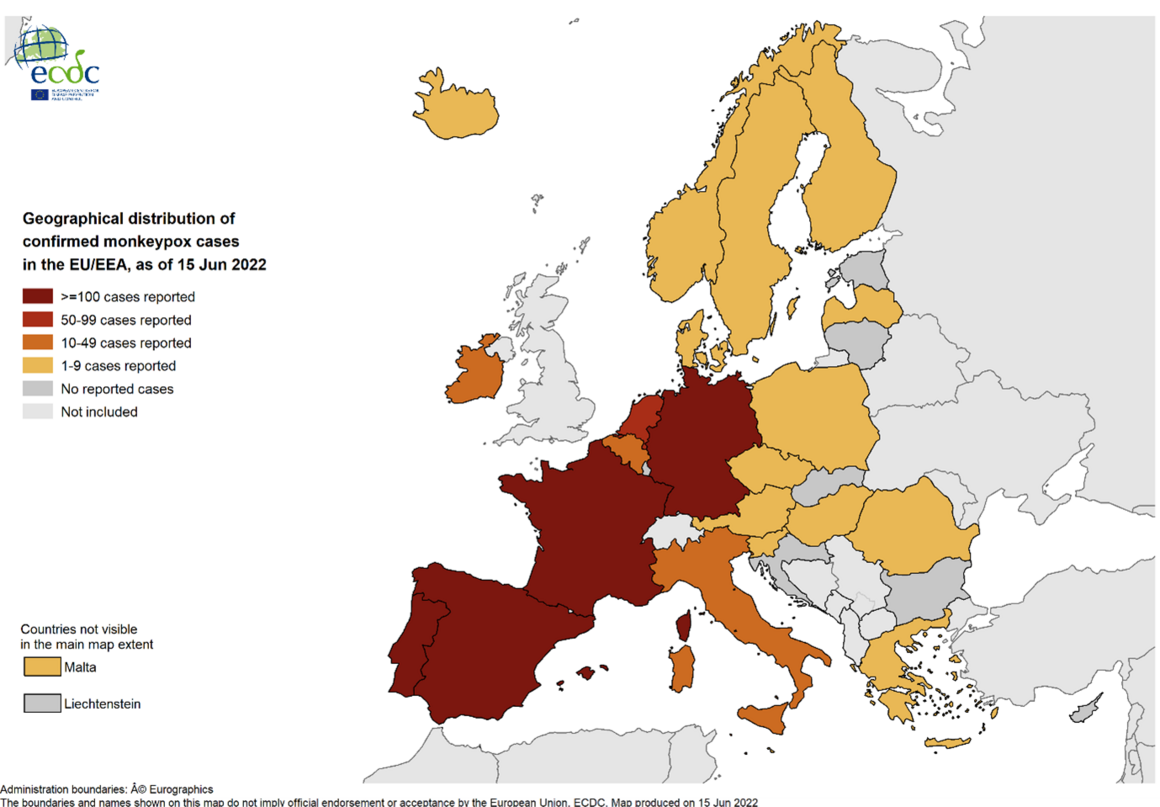
Worldwide update
As of 15 June 2022, 724 confirmed cases of monkeypox have been reported from 13 non-EU/EEA countries: United Kingdom (470), Canada (112), United States (72), Switzerland (20), Australia (13), United Arab Emirates (13), Argentina (5), Ghana (5), Mexico (5), Israel (4), Brazil (3), Morocco (1) and Venezuela (1).
Figure 2. Geographical distribution of confirmed cases confirmed cases of MPX worldwide, as of 15 June 2022
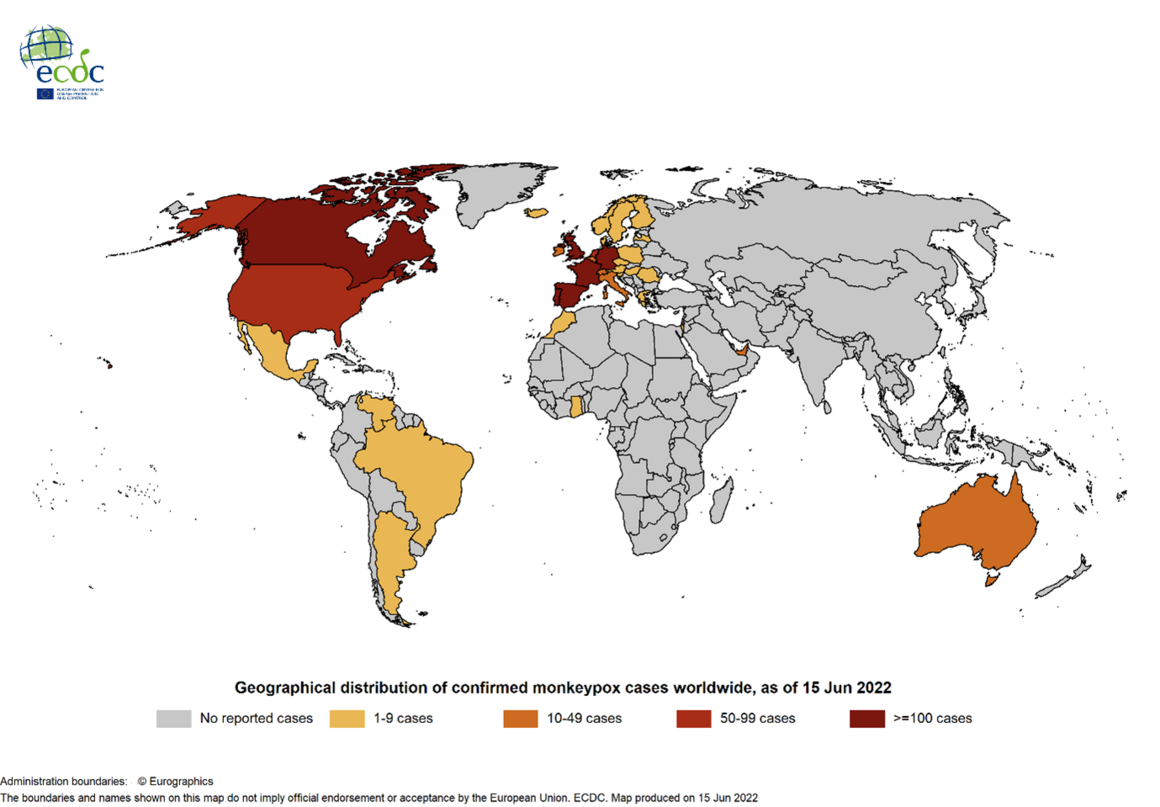
Phylogenetics of monkeypox virus
The monkeypox virus (MPXV) has a double-stranded DNA genome of ~197 kb [1]. Two genetically distinct major clades have been described: the Central African (Congo Basin) and the West African clade [2]. Whole genome sequences of MPXV were extracted from GISAID EpiPox and GenBank. The phylogeny was performed using ParSNP [3] with MT903344.1 as reference and visualised in Microreact [4]. The sequences from the West African clade are presented in Figure 3.
The EU outbreak sequences are a part of a distinct cluster from 2022 within the West African clade. Limited sampling and sequencing of MPXV over the years makes it difficult to generate a hypothesis on the source of introduction for this outbreak.
Sequencing of MPXV can help us understand virus transmission and patterns of spread. Therefore, ECDC recommends that countries deposit whole genome or partial genome raw reads and assemblies to the databases available for sequence sharing. Accession numbers can be reported in the standard data fields in TESSy. If public sharing is not feasible due to data privacy or for other reasons, ECDC encourages countries to submit assemblies by attaching them to the monkeypox event in EpiPulse or to upload data to the ECDC Sftp site. For further instructions, please e-mail typing@ecdc.europa.eu.
Figure 3. Phylogenetic tree of monkeypox virus sequences from West African clade as of 14 June 2022.
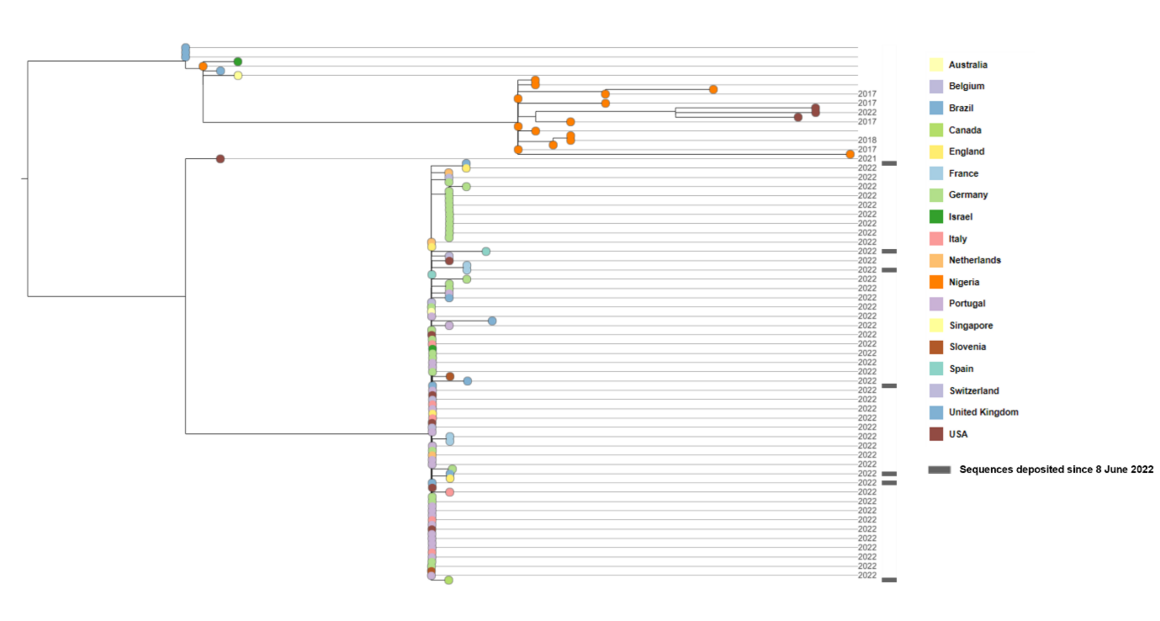
ECDC risk assessment
The trajectory of the outbreak as of now does not affect the risk as previously assessed by ECDC in the ‘Monkeypox multi-country outbreak’ Rapid Risk Assessment published on 23 May. The likelihood of MPX spreading in persons having multiple sexual partners in the EU/EEA is considered high. Although most cases in current outbreaks have presented with mild disease symptoms, monkeypox virus (MPXV) may cause severe disease in certain population groups (young children, pregnant women, immunosuppressed persons). However, the likelihood of cases with severe morbidity cannot be accurately estimated yet. The overall risk is assessed as moderate for persons having multiple sexual partners (including some groups of MSM) and low for the broader population. Identification of cases and contact tracing as well as community engagement and risk communication activities remain the most important response options.
Case definition
Confirmed case
A person with a laboratory-confirmed monkeypox infection (1) monkeypox virus-specific PCR assay positive result or (2) orthopoxvirus-specific PCR assay positive result which is then confirmed by nucleotide sequence determination of the detected virus as MPXV with symptom onset since 1 March 2022.
Probable case
(1) A person with an unexplained rash* on any part of their body
AND one or more other symptom(s) of monkeypox infection** with symptom onset since 1 March 2022
AND one of the following:
- has a positive laboratory test result on orthopoxviral infection (e.g. orthopoxvirus-specific positive PCR without sequencing, electron microscopy, serology);
- has an epidemiological link to a confirmed or probable case of monkeypox in the 21 days before symptom onset;
- reports travel to MPX-endemic countries in the 21 days before symptom onset;
- is a person (of any sexual orientation) who had multiple or anonymous sexual partners in the 21 days before symptom onset;
- is a man who has sex with men.
OR
(2) A person with an unexplained generalised or localised maculopapular or vesiculopustular rash with centrifugal spread, with lesions showing umbilication or scabbing, lymphadenopathy and one or more other MPX-compatible symptoms**.
* Since EU/EEA countries are just starting to identify cases and if testing capacity is sufficient, the above more sensitive case definition can be used. In countries with limited testing capacity for orthopoxviruses, the following description can be added to characterise the rash: ‘unexplained localised or generalised maculopapular or vesiculopustular rash potentially with umbilication or scabbing’.
**Fever (usually higher >38.5°C), headache, backache, fatigue and lymphadenopathy (localised or generalised).
References
[1] Kugelman JR, Johnston SC, Mulembakani PM, et al. Genomic variability of monkeypox virus among humans, Democratic Republic of the Congo. Emerging Infectious Diseases. 2014;20(2):232-239. Available at: https://www.ncbi.nlm.nih.gov/pmc/articles/PMC3901482/
[2] World Health Organization. Monkeypox factsheet. 2022. Available at: https://www.who.int/news-room/fact-sheets/detail/monkeypox
[3] Treangen TJ, Ondov BD, Koren S, Phillippy AM. The Harvest suite for rapid core-genome alignment and visualization of thousands of intraspecific microbial genomes. Genome Biology. 2014;15(524). Available at: https://genomebiology.biomedcentral.com/articles/10.1186/s13059-014-052…
[4] Argimón S, et al. Microreact: visualizing and sharing data for genomic epidemiology and phylogeography. Microbial Genomics. 2016;2(11). Available at: http://mgen.microbiologyresearch.org/content/journal/mgen/10.1099/mgen…
[5] NBC News. Two distinct monkeypox variants found in U.S., adding to outbreak’s mystery. 2022. Available at: https://www.nbcnews.com/health/health-news/two-monkeypox-variants-found-us-rcna31894
[6] MedPage Today. CDC: Two Distinct Monkeypox Strains Detected in U.S. 2022. Available at: https://www.medpagetoday.com/infectiousdisease/generalinfectiousdisease/99052




